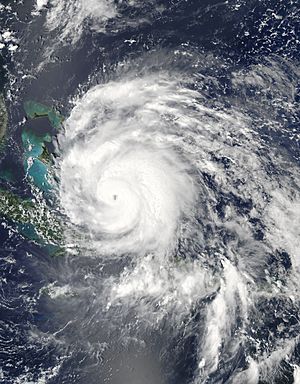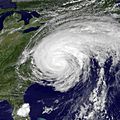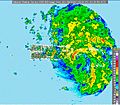Hurricane Irene facts for kids

Hurricane Irene at peak intensity over the southern Bahamas on August 24
|
|
| Meteorological history | |
|---|---|
| Formed | August 21, 2011 |
| Extratropical | August 28 |
| Dissipated | August 30, 2011 |
| Category 3 tropical cyclone | |
| 1-minute sustained (SSHWS/NWS) | |
| Highest winds | 120 mph (195 km/h) |
| Lowest pressure | 942 mbar (hPa); 27.82 inHg |
| Overall effects | |
| Fatalities | 49 direct, 9 indirect |
| Damage | $14.2 billion (2011 USD) |
| Areas affected | Hispaniola, Lesser Antilles, Greater Antilles, Turks and Caicos, Bahamas, East Coast of the United States, Vermont (Landfalls in North Carolina, New Jersey, New York, Atlantic Canada) |
|
Part of the 2011 Atlantic hurricane season |
|
Hurricane Irene was a very big and powerful tropical cyclone (a type of storm like a hurricane or typhoon) that caused a lot of damage. It hit many places in the Caribbean and along the East Coast of the United States in August 2011.
Irene was the ninth named storm of the 2011 Atlantic hurricane season. It was also the first hurricane and the first major hurricane (meaning it was very strong) that year.
The storm started as a "tropical wave" in the Atlantic Ocean. This is like a ripple in the atmosphere that can grow into a storm. On August 20, 2011, it became Tropical Storm Irene. It quickly got stronger.
Irene first made landfall (when the center of the storm crosses land) in St. Croix. Later that day, it hit Puerto Rico. While moving over Puerto Rico, Irene grew into a Category 1 hurricane. It then moved near Hispaniola and kept getting stronger.
Before hitting the Bahamas four times, Irene reached its strongest point. It was a Category 3 hurricane with winds of about 120 miles per hour (195 km/h).
Contents
Irene's Journey: From Bahamas to New York
After reaching its peak strength, Hurricane Irene started to weaken a bit. It moved through the Bahamas and then turned north. It passed east of Grand Bahama.
Hitting the United States Coast
Irene continued to get weaker. It was downgraded to a Category 1 hurricane before it made landfall in the Outer Banks of North Carolina on August 27. This was the first hurricane to hit the United States since Hurricane Ike in 2008.
Later that same day, the storm moved back into the Atlantic Ocean from southeastern Virginia. Even though it was still a hurricane over the water, it weakened into a tropical storm. It then made another landfall in Little Egg Inlet in southeastern New Jersey on August 27.
Just a few hours later, Irene made its ninth and final landfall in Brooklyn, New York City.
Becoming an Extratropical Storm
Early on August 29, Irene changed into an extratropical cyclone. This means it lost its tropical features and became more like a regular storm you might see in colder areas. This happened while it was hitting Vermont. Irene had been over land as a tropical storm for less than 12 hours before this change.
Impact and Damage Caused by Irene
Hurricane Irene caused a lot of damage and sadly led to many deaths. Across its path, at least 49 people died directly because of the storm. Another 9 deaths were indirectly related to it.
Cost of the Storm
The damage in the United States alone was estimated to be around $13.5 billion. This made Irene one of the most expensive hurricanes ever recorded in the country.
Besides the U.S., the Caribbean suffered about $830 million in losses. Canada also had about $130 million in damage. In total, the storm caused nearly $14.2 billion in damage.
Images for kids
-
A restaurant boards up in preparation for Irene in Ocean City, New Jersey
-
Grand Central Terminal stands empty following the shut down of the Metro-North Railroad.
-
Flooding at Chincoteague National Wildlife Refuge on Assateague Island
-
A downed tree branch in Kutztown, Pennsylvania
-
Storm surge flooding in Centerport, New York as the eye of Irene passed near high tide.
-
A road washout in New Windsor
See also
 In Spanish: Huracán Irene para niños
In Spanish: Huracán Irene para niños

























